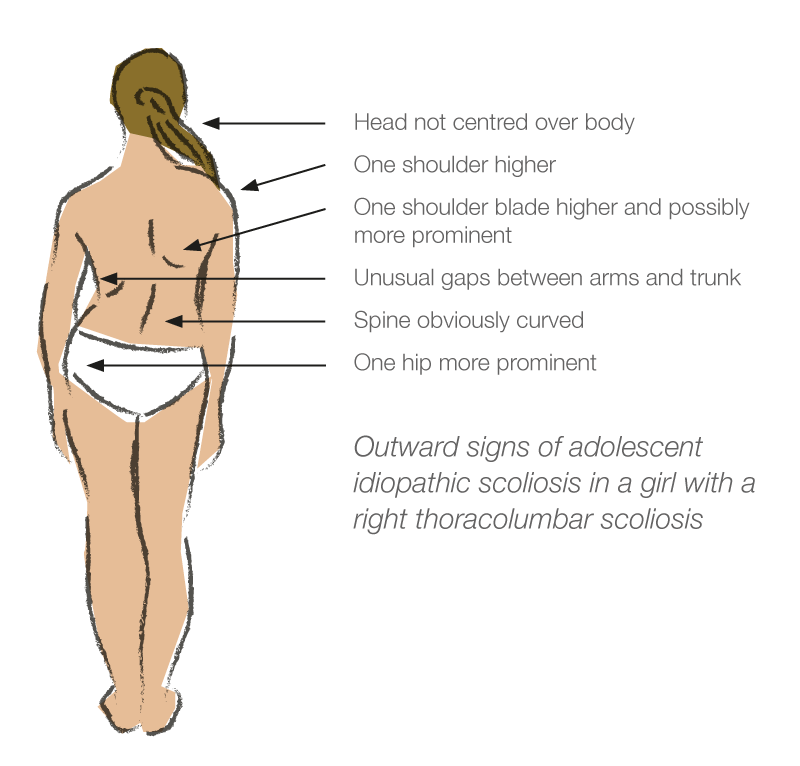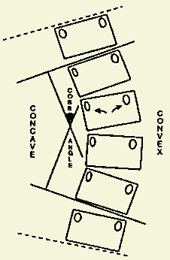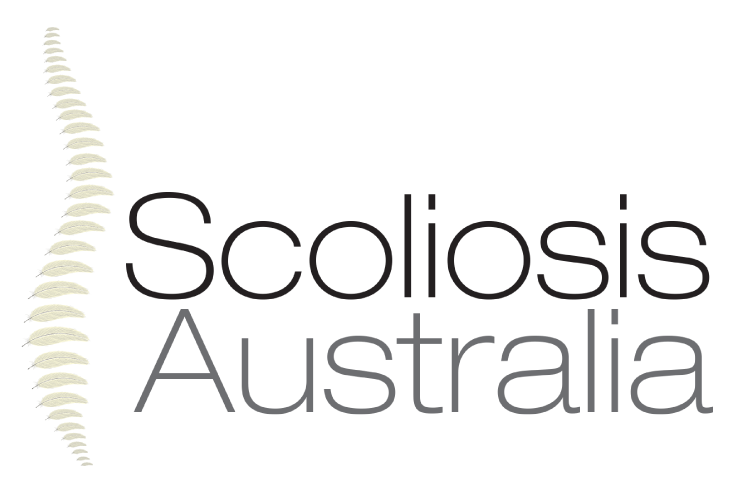Role of the family doctor in the management of scoliosis
This information sheet summarises the diagnosis and management principles of adolescent idiopathic scoliosis (AIS). Examination of the spine is recommended for all adolescent girls whenever they visit their family doctor.
A full paper on this subject is available on this website.
Each year in Spring, all public and private schools in Australia should download the Scoliosis Detection Fact Sheet from this website and distribute it to girls in Years 5 and 7. If they, or their parents, think they may have a curve, follow-up with the family doctor is advised. This program is recommended by the Spine Society of Australia. The program is endorsed by the Paediatrics and Child Health Division of the Royal Australasian College of Physicians.
Scoliotic Deformity
AIS develops about 10 years of age in a previously normal spine. It deforms in the coronal and sagittal planes together with rotation in its long axis. The vertebral body rotates to the convex side and the spinous processes to the concave. The ribs follow the vertebrae rotating backwards and upwards on the convex side and forward to a lesser degree on the concave.
Curve Patterns
The right thoracic curve is the most common pattern followed by the left lumbar curve.
Prevalence
2%-3% for curves 10º or more; 0.1% for curves >40º.
Sex Incidence
The male-female ratio for curves warranting treatment is 1:10.
Diagnosis
This is best made when the trunk is viewed from behind. In a right (R) thoracic curve the R shoulder is elevated. The R scapula moves upwards and laterally with a prominent medial edge. Because of trunk rotation, the L costal margin may be more prominent than the R. Flank creases may be asymmetrical. The gaps between the dependent arms and the trunk are unequal. The L iliac crest (hip) is more prominent than the R. The latter may be the presenting signs in thoracolumbar and lumbar curves.
The Forward Bend Test (FBT)
This diagnostic physical sign is based on fixed (structural) vertebral column rotation. The subject bends maximally forward with outstretched arms, palms facing each other, pointed towards the great toes with the feet together. This brings the rib prominence or lumbar muscles into silhouette. A significant curve is likely if the difference between the heights of the two sides is >1cm.
What Are The Outward Signs Of Scoliosis?

How Do You Detect Scoliosis?
Simply look for it!
It only takes 30 seconds.
Torso Asymmetry
This is the most common reason for a false positive FBT. It is due to asymmetrical growth/development of the two sides of the body and is present in about 40% of normal girls. Here, in the FBT, the difference between the height of the two sides is <1cm. The other signs of scoliosis are absent. If you are having difficulty deciding whether a girl has a curve, then almost certainly she does not. Such asymmetry is of no clinical significance.
Symptoms
In the early stages, AIS causes no symptoms. A painful scoliosis is an indication for investigation for underlying pathology such as tumour.
Curve Measurement (The Cobb Angle)
This must be done accurately on an erect PA film (diagram). The minimal angle for diagnosis is 10º with vertebral rotation.
Scoliosis Of Other Aetiologies
AIS is a diagnosis by exclusion. A full physical examination is required including neurological assessment. Spinal curvatures may be associated with neuromuscular disease, connective tissue disorder and congenital vertebral abnormalities.
Specialist referral is recommended for these conditions. A true or apparent limb shortening may produce a lumbar tilt but no scoliosis. This is because there is no vertebral rotation. A short leg “scoliosis” disappears on sitting and blocking the short leg to correct the pelvic obliquity. The spine appears straight with no truncal rotation in the FBT.
Management
This is based on the age at presentation and the degree of curvature. The risk for progression is established (table) and this most likely occurs in the growth spurt (10-13 years for girls). Early breast development marks spurt onset.
Risk of Progression of AIS (Females)
| Degree of Curve (Cobb Angle) | Age 10 – 12 | Age 13 – 15 | Age over 16 |
|---|---|---|---|
| < 20 deg | 25% | 10% | 0% |
| 20 – 30 deg | 60% | 40% | 10% |
| 30 – 60 deg | 90% | 70% | 30% |
| > 60 deg | 100% | 90% | 70% |
For curves <20º: observation only through the growth phase on a six-monthly basis. Specialist referral required if progression.
For curves 20º- 40º: bracing may be required if there is significant growth remaining.
For curves >40º- 45º: surgery may be indicated.
There is no scientific evidence that physical therapy (exercise programs) and spinal manipulation (chiropractic adjustments) will halt progression of a significant structural scoliosis.
No restrictions are placed on any activity – this includes sport. Detection of a curve is an indication of examination of siblings. AIS may be inherited on an autosomal basis.
Minor curves (<20º) are common but only 3 adolescent girls per 1000 have a curve which requires active treatment, either by bracing or surgery.
The Forward Bend Test
30 Seconds Well Spent For An Adolescent Girl And Her Family Doctor
A positive forward bend test in a girl with a thoracolumbar curve. Thoracic curves are best detected with the examiner standing directly behind the subject and in front for thoracolumbar and lumbar curves.

Measurement Of The Cobb Angle On An Erect Pa X-Ray

The angle is measured at the intersection of perpendiculars drawn to lines parallel to the upper and lower surfaces of the most tilted vertebrae (solid lines). Measurements using the vertebrae above and below (dotted lines) would give a false value. When a vertebra rotates the pedicle shadows become asymmetrical and are no longer on the margins of the vertebrae. (arrows).
